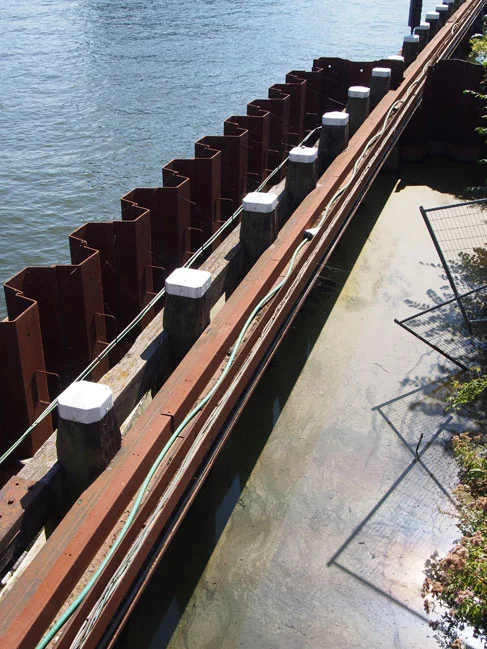As August is a good time for reflecting on your creative practice, when you have the time and energy to stop for a bit and examine how things are going, I thought I’d continue looking at my own creative practice here on the blog. I regularly write about what I’m up to, creatively, I find it helps me when I get stuck or it allows me to consider things that usually happen spontaneously that I don’t necessarily pay much attention to. I genuinely believe it benefits makers to really consider why they make things, as well as how. I recommend that people try to write about what they are doing with their making, regularly, unguardedly, as a way to understand what is happening. These thoughts are not necessarily meant to be essays in the formal, academic sense, but they are essays in the etymological sense – they are trials and testings, an attempt at figuring things out.
……………………………………….
A barrier of corrugated iron separates the blue harbour water from a standing pond-like volume. Its surface is slick and still, there is a layer of something floating on the surface which diffracts the light like the halo around the moon, rainbowy and pale. Behind the iron zipper teeth is a line of wooden posts, topped with slabs of white, they look like extra strong mints that have been squared. More iron, but a paler brown, conduits for lines of wires – palest blues and a wobbly line of aqua green. The bank of the river holds back two metal wire fence panels, which have fallen towards the water, but don’t quite touch. Their regular grills silhouetted on the beigey muck below. The whole scene is one of contrast of colour, texture and materials.
I am aware that it was on this trip to Amsterdam that I began to collect building materials as swatches, reveling in the combinations of stone, metal, glass and wood. There was no better way to record these moments, to remember how the blue of the water sits so perfectly next to the orangey iron. And, predictably, the line of posts, the teeth of the barrier, heading off into the distance diagonally, bisecting the shot, balancing out the areas of colour and surface. The image feels right. This balance, these contrasts, there is nothing unsettling. It is kept interesting by the zigzag of the metal fence and its shadow below – spiky and lightweight in comparison to the barrier, but of a kind with its regular mesh and in-and-out motion.
It was a wonderfully warm afternoon and we were walking around the harbour, peering into the houseboats and the water beyond to the city. I had not completely understood that this was what Amsterdam was like. I had only the postcard version in my head, of medieval narrow houses and canals with boats and bikes. I had not realized that the water flowed out into bigger courses and expanses. That there was so much modern along these fringes, that there were communities of people who were seeking a simple lifestyle away from the picture-perfect tourist attraction. It is so hard when visiting a city like Amsterdam for the first time, not to get carried away by the pretty. To try to see more of the real. (I’m not even sure that it gets easier with time or repetition – I am still swain by the beauty of Oxford, even after 37 years of familiarity.) But I know that I managed, somehow, to not only see the façade that Amsterdam wears for its guests. When I look through the pictures I took on that trip, so many of them are like this one – aspects of architecture or building materials, light caught on a surface or highlighting a plane. They could be anywhere, and yet they could not. I would know at a glance where they were taken, I could even tell you where we had been walking to get there.
